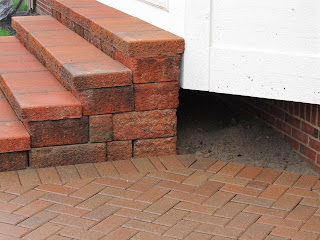Old asphalt driveway replaced with long-term Interlocking Brick Pavers
In Ann Arbor this Fall, we replaced an old dilapidated asphalt driveway that was not only unsightly, but pitched rain water back towards the garage. There are many decisions to be made when replacing an old driveway and considering interlocking brick pavers. Brick pavers is usually your best long-term option.
It is true that interlocking brick pavers are going to be one of your more expensive options but over the course of several years, it becomes one of the most economical solutions. When you factor in aesthetics,routine maintenance, repair & replacement costs, interlocking brick pavers will be your best long term financial option.
The biggest reason brick paver driveway installations cost more is because the base prep under the pavement far exceeds, sometimes 5 times, any prep work done for concrete, asphalt, or stamped concrete installations. Make sure you are asking the right questions and and what are warranty periods when considering your pavement options.

We started this brick paver driveway project by doing some core tests to check the base material under the asphalt. When I bid a brick paver driveway, I always discuss the possibility of some cost savings or additional costs due to the unforeseen conditions below. In this case, we discovered that there was approximately 10-11 inches of gravel base under the pavement.
 Since we were going to raise most of the driveway height 1-2", we were confident that there was an adequate depth of base material present for a brick paver driveway. We did skim off the contaminated layer of top base and installed a reinforcement layer of strata grid in the upper half of the existing base material.
Since we were going to raise most of the driveway height 1-2", we were confident that there was an adequate depth of base material present for a brick paver driveway. We did skim off the contaminated layer of top base and installed a reinforcement layer of strata grid in the upper half of the existing base material.We did saw-cut the garage floor to give a clean transition line for the paving stones and set the pitches to better flow surface water away from the garage. It is always a challenge to properly channel water flow when the street is higher than the garage floor. The homeowner really wanted to avoid the use of drains if possible and we made that happen. We properly surveyed the project to achieve maximum water flow across the surface of the paving stones.
We installed 2 large circle patterns in the middle of the pavers driveway to match their current paver patio design. We filled in the "field", the area between any designs & soldier course borders, with a random pattern to improve the weight distribution strength of the paving stones.
 The final result was a dramatic transformation from the drab potholed asphalt drive they endured for many years. They now enjoy a dry garage floor and are the envy of the neighbors.
The final result was a dramatic transformation from the drab potholed asphalt drive they endured for many years. They now enjoy a dry garage floor and are the envy of the neighbors.We were able to contract a neighbor for another paver driveway transformation next Spring. The creative design and long term performance of brick pavers is unmatched in frost states such as Michigan.


















































